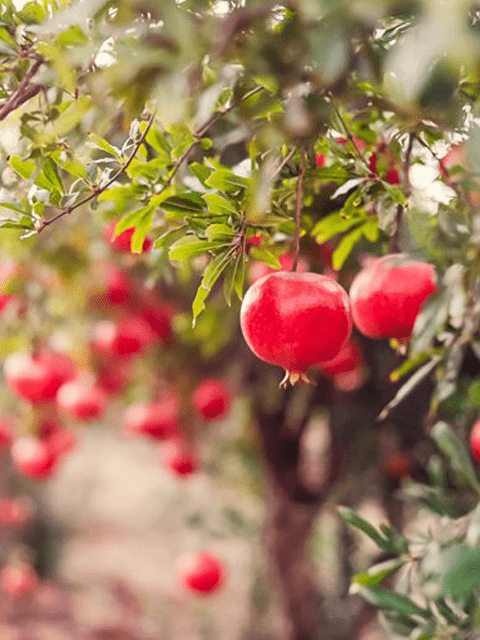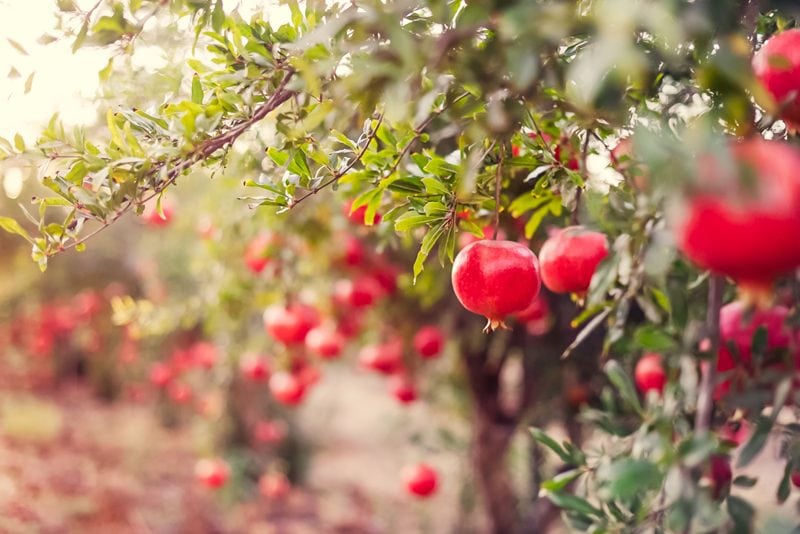


 Add to favorites
Add to favorites
If you haven’t tried pomegranates, now is the time. I wasn’t introduced to them until my late twenties and fear of the unknown kept me from ever buying them. Shame on me. I was missing out. Something I don’t want you to do… so please take my words as those of encouragement. :)
First off, you will find pomegranates growing on a shrub or small tree which can reach between 20 or 30 feet in height. The trunk is covered by a red-brown bark which later becomes gray. The branches are stiff, angular, and often spiny. Pomegranate trees have been known to reach the age of 200! The vigor of a pomegranate declines after about 15 years, however.

The leaves are glossy, leathery, narrow, and lance-shaped and during the Spring they will be joined by attractive scarlet, white or variegated flowers. The flowers may be solitary or grouped in twos and threes at the ends of the branches. The pomegranate is self-pollinated as well as cross-pollinated by insects. Cross-pollination increases the fruit set.
Their outer skin is tough and leathery and isn’t meant to be eaten. The interior is separated by membranous walls and white, spongy, bitter tissue into compartments packed with sacs filled with sweetly acid, juicy, red, pink, or whitish pulp or aril. In each sac, there is one angular, soft, or hard seed. High temperatures are essential during the fruiting period to get the best flavor. The pomegranate may begin to bear in 1 year after planting out, but 2-1/2 to 3 years is more common. Under suitable conditions, the fruit should mature some 5 to 7 months after bloom.
When choosing a pomegranate, look at weight, not color. I have to admit, this is hard for me, as I always gravitate to the bright colored fruits. The outside of a ripe pomegranate can vary from light pink to a deep ruby-red, but that’s not what’s important; the heavier the fruit, the more juice it contains–which means it’s that much more delicious. Pomegranates stop ripening as soon as they are picked.
Look for ones that have smooth skin, free from any bruises, cuts or mold. Once you get them home, store them in a cool dark place at room temperature for 5-8 days or more. But not so dark that you forget about them. I have the “been-there-done-that” award in this category. You can also keep them inside the refrigerator for a couple of weeks.
For longer storage, you can de-seed and freeze the arils whole. Another option is to extract the juice by running the arils through a food strainer or a blender and straining out the seeds; the juice can be frozen for up to 6 months.
Beautifull, Thanks :)
Thank you Lka :)
Thank you, Amie Sue
I used to be a frustrated picker-outer of seeds… Now I will be a happy-healthier consumer of Pomegranates! Looking forward to up coming recipes!! :D
frustrated picker-outer of seeds… no more Wendy. hehe
dear amie sue
i would like to know what kind of raw probiotics you recommend to make yougurt with almond and seeds??? do you have recipes of this? Im from Argentina.
I really will like to see you in a video.
Sometimes i don’t have the ingredients that you use. But i love your brightness creating flavour not only sweets… specially breads, crakers, snakcs, salad dishes… you are incredible.
and best of this is that you share them…. because you know knowledge is inside of you.
peace and more ki for you from the south
;-)))))))
Good morning Carolina,
I use a probiotic called PB 8 Probiotic. https://nouveauraw.com/ingredients/superfoods/nutrition-now-pb-8-pro-biotic-acidophilus-tablets-vegetarian-120-count-bottles/
Here is a recipe using coconuts as the yogurt base: https://nouveauraw.com/raw-recipies/breakfast/young-thai-coconut-yogurt/
I do have a recipe using cashews but haven’t released the recipe yet, I will work on sharing those asap.
Have a blessed day, amie sue
We’ve been enjoying pomegranates for years and just recently found this method you so beautifully displayed. The only thing I might add is to keep the red juice from splattering I put it inside a gallon size freezer bag, seal it and then spank it. All the mess is contained inside.
Then I pour them out on a baking sheet, freeze ’em individually and bag ’em. We enjoy them for many months that way.
Great tip Sandy. I didn’t seem to notice this being a problem but if they are really juicy… this would be a good thing to do. Thank you for sharing this with us. amie sue :)
Whoa! Good trick! Thanks for sharing–can’t wait to try it.
Your welcome The mama :)
Thank you so much, Amie Sue, I didn’t know that. So helpful! Warmest regards, AM
Your welcome Anne-Marie :)
could you share info on using a phersymins fruits ? thanks
Hello Michele,
Are you referring to persimmons? And what would you like to know? amie sue
ah ha…so that’s how you do it!!!
thx for sharing – you know I love everything Amie Sue…;-)) Love you
Love you too Ruthie! :) hugs
Yes, this is the method that I use. found it on youtube. I use a long handled heavy wooden spoon to do the spanking..(ohhhh, that hurts!!) and it really knocks those little jewels right out of there. k.
It is amazing how many techniques that there are. You are right, they are little jewels. :) Have a great day Kate!
Thank you for sharing this it is very helpful. I’m looking forward to eating pomegranates so I can try it!:)
Your welcome Christine :)
Oh, Thank you, thank you for this great method! I might sound the stupidest girl in the world for those who figured this out before me, but you really changed my life, Amie-Sue. I just finished a bowl of pomegranate seeds (which I had not had for years), and it is actually delicious! Have a great day! ^^ :-)
One life saved… time for a tea break. hehe Your so sweet. :) We all learn new things every day… being able to share them with others is half the fun. Enjoy those pomegranates! I know I sure do now. Have a great weekend, amie sue